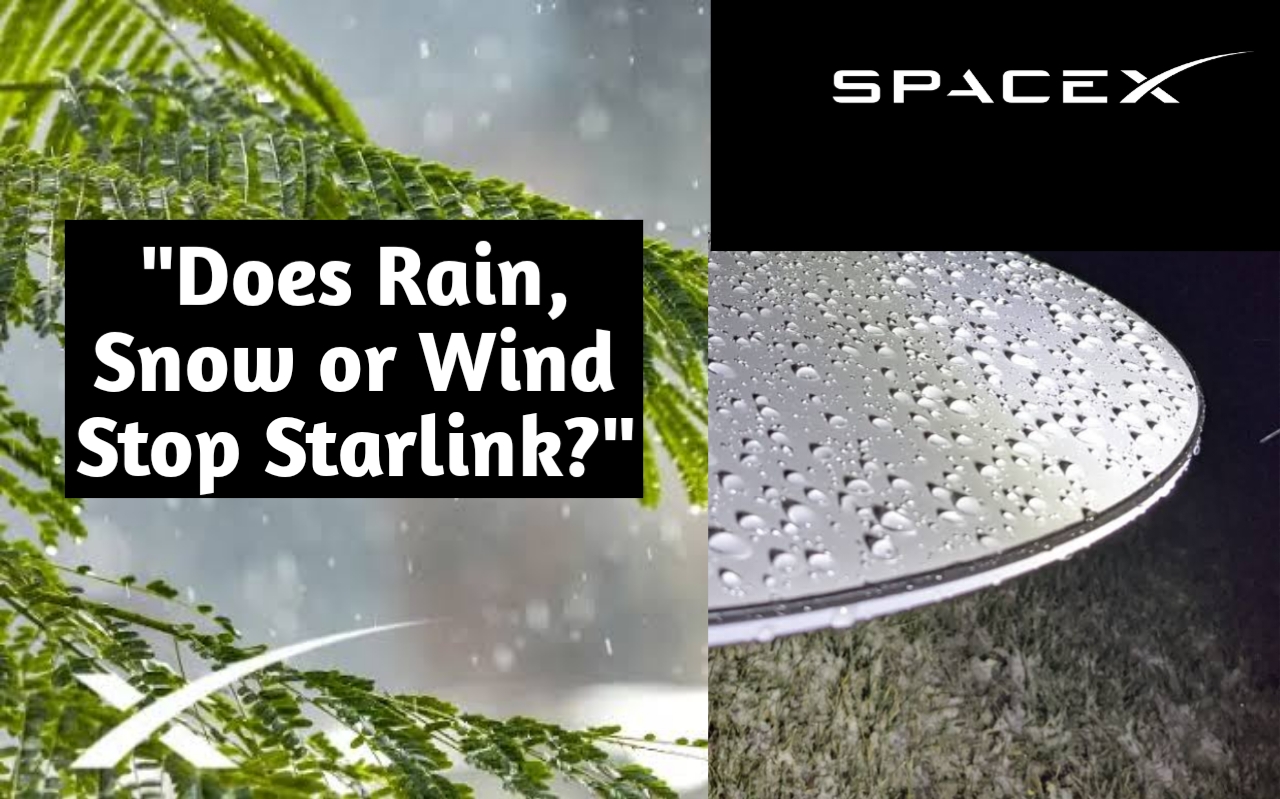Any kind of satellite internet is affected by the weather. However, if your internet stops working at the first sign of rain, it is useless. Light snow and rain do not affect Starlink. On the other hand, it may experience a brief interruption during severe weather or heavy snowfall. The speed may slow by 30 to 40 per cent more than usual. Starlink users in low-capacity areas face the greatest difficulties because of weather conditions. So, lets learn ‘does starlink work in bad weather’?
How fast does Starlink function in bad weather?
The weather usually affects how fast Starlink goes. Heavy rainfall can cause brief blackouts and lower speeds. However, problems can arise in case of heavy, wet snow. Dry, fluffy snow is not an issue. Starlink typically is unaffected by fog, wind and temperature. Nevertheless, the dish must be secured at all costs. The dish is designed to withstand extreme temperatures. Most of the issues that Starlink has with the weather are directly related to the amount of moisture in the air.
Radio frequency waves have trouble reaching a satellite that is cutting through the air’s water. The Starlink Coverage Map shows areas with low capacity. According to the data, the degree to which bad weather affects your Starlink connection is correlated with where you live. So, the answer to the question “does starlink work in bad weather” is ‘Yes’.
Southern and Midwest states make up most of the low-capacity regions in the red outline. Additionally, Starlink’s weather-related issues appear to be more prevalent in the United States than in Canada, the United Kingdom, or Australia, which all have much fewer users. Go through the resources of Starlink to know more about the company’s base.
How to reduce the impact of bad weather on Starlink?
It isn’t much you can do in bad weather. However, you should complete some fundamental tasks. Make certain that your dish is facing north. Starlink dishes can occasionally become disoriented and point in different directions when it rains a lot. You need to put it away and power cycle it here. Then, untie it to point in the right direction (North).
Clean the dish of snow and other debris: The dish may become physically covered in ice and debris during severe snowstorms. Make sure the dish is clean before using it. If you live in a location like this, you must always keep the snowmelt feature turned.
Make sure there are no obstructions in your dish: This ought to be carried out regardless of the weather. However, bad weather can make an already obstructed dish perform worse. If you live in a heavily wooded area, getting your Starlink up on a tall tree or tower may be your only option for getting it to work properly.
Starlink’s Backup Options in Bad Weather: You should consider having an internet backup if you experience outages every time it rains. This doesn’t happen very often, but it can happen from time to time. 4G LTE or 5G home internet are the best options for those who live in areas with cell service.
Unlike Starlink signals, which must travel hundreds of miles, wireless internet signals only need to get to the nearest cell tower. In bad weather, there is a greater chance of obstruction the further away you are. Starlink can use LTE as a failover system if it has a good plan from AT&T or Verizon. Check and resolve if Starlink is down, click here.
What problems does Starlink typically face when the weather is bad?
Lightning issues:
If your dish is at the highest point in the area, lightning can be an issue for Starlink. Several Starlink users have reported lightning strikes burning their adapters and routers or frying their dishes.
You need to take precautions if your Starlink is mounted on a 40-foot tower or at the very top of your roof, atop a pole. No matter what you do, a direct lightning strike will irreparably harm your dish. However, lightning-related accidents and fires can be avoided by taking precautions.
Saving Starlink Dish From Lightning
Running a lightning arrestor, also known as a ground wire, is the most effective method of lightning protection. The lightning’s electric charge will be safely guided into the ground by this. If you want to do this right, ask an electrician for help. You shouldn’t take this lightly at all. A surge protector should also be installed in your home to shield your device from the inside. Even though it can’t completely stop lightning, it does help.
When you intend to not use your dish for an extended period, Starlink also recommends unplugging it. Due to their geography, some states in the United States, like Florida, are particularly vulnerable to lightning strikes, learn here why.
Snow Problem:
The kind of snow that falls is what determines how it affects Starlink. Starlink is barely affected by fluffy, drier snow, whereas heavy, wet snow causes outages and slower speeds like rain. The snow’s moisture determines whether the snowstorm will influence Starlink’s performance. Starlink is unaffected by even several feet of snow because there is less moisture in the snow.
How To Protech Starlink Dish From Snow
If you live in a place where it snows, make sure the heating and snowmelt feature is turned on. Even though turning this feature off can save some power, you might lose your connection if it snows a lot. You won’t be able to turn on the snowmelt until the storm passes because you must use the app and be connected to the internet. For your dish to function at its best, clear it of snow and other debris.
Wind Problem:
Starlink’s internet speed and dependability are virtually unaffected by wind. You should be more concerned about storms and hail. These are caused by wind on your Starlink connectivity so you should be about pure winds. When there are hurricanes or very strong winds (up to 75 mph), wind becomes a concern because it can damage your dish.
The Starlink dishes have been tested by Starlink up to a wind speed of 75 mph, but the company does not guarantee that they will hold up at that speed. This is to be expected because, in addition to the wind speed, many other factors influence how the wind affects your dish. If you’re expecting a hurricane, it’s best to take your dish off and put it back on later.
If your Starlink is not mounted correctly, wind can also have an impact on its performance. The dish can sway in the wind and cause possible reception issues if the mounting is loose. However, users who have mounted their Starlink on tall trees with sways as high as 3 feet have reported that the device’s tolerance for sway is high. In any case, you must select the appropriate Starlink mounting accessories. Check out the Starlink map and see where is the service available.
We hope you like this article ‘does starlink work in bad weather’. You can support us on our Youtube Channel too by ‘subscribing’. Have a great day.
You May Also Like To Read-
How much power does starlink use?
Is Starlink Internet best for gaming?
Starlink Router / Power Supply All Lights Meaning?
How to contact Starlink Customer Support?
Is starlink available in my area? Check Here!
How to Cancel any item from Starlink Order?
How many Starlink Satellites are in the orbit?
What is Subaru Starlink? Is it a must for vehicals?
How to Setup Starlink Mesh Node? In Just 2 mins!
Why my starlink order status says preparing order?
How to see Starlink satellites? Via App and Telescope!
Official Starlink Firmware Update Releases: Listed here
Starlink puts 1TB Data Cap Under Fair Use Policy, is it Fair?
When will I receive my starlink? How much time will it take?
How big is a Starlink satellite? Thrice the average person’s height!
Starlink In motion Internet Service for $2,500? Starlink for RV!
How fast is Starlink Internet? Is it better than Hughesnet or Viasat?
How much is the Starlink Limited Warranty Period? 24or12 months!
What is starlink? Everything you should know for this latest technology!
Order Starlink Maritime at $10,000, Everything you need to know! [2023]

